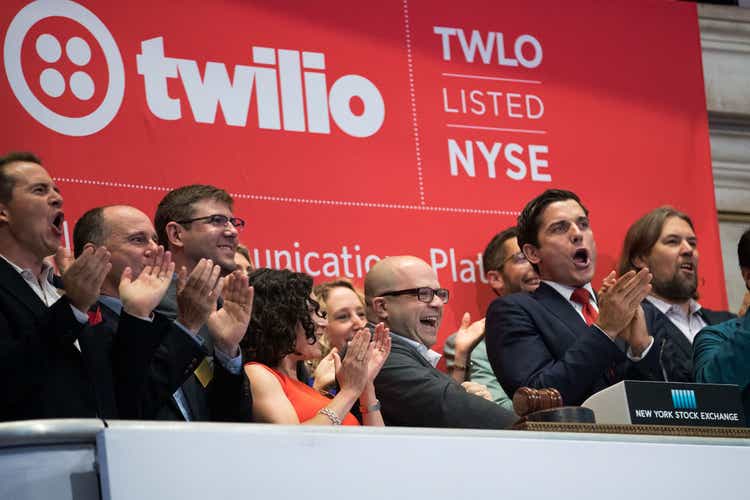
Drew Angerer
It has long been my thesis that Twilio (NYSE:TWLO) was a bubble stock. My thesis, more than being based on Twilio’s outrageous valuation, was based on two other realities:
Now that Twilio has crashed – Twilio is down by more than 82% since its 52wk high, and even down nearly 50% from my first article on it, written as far back as 2019 – I think it’s time to revisit Twilio and see if anything changed. It’s time to try to establish whether Twilio might now be cheap or whether prospects might have improved. So, let’s do this.
The Obsolescence Thesis
Not much has changed. Particularly on the authentication area, it’s even better known that using SMS for 2FA (2-factor authentication) is undesirable from a security standpoint. Hence, more and more apps, use cases and companies are trying to move away from SMS use for that purpose.
At the same time app-based messaging is faster, more reliable and cheaper than using SMS. Not all use cases are possible (for instance, in the absence of an installed app or browser session), but the realization that otherwise SMSs are an incredibly inferior alternative can’t but take hold.
There’s little to drive away this thesis. SMSs aren’t going to improve – they’re static. It’s just a matter of time until they’re driven out by other forms of in-app messaging.
The Competitive Sector Thesis
When I first started writing about Twilio, around 3.5 years ago (early 2019), Twilio had around $650 million in revenues (2018), and not much to show in terms of profits ($115 million GAAP loss from operations).
Fast forward 3.5 years, several acquisitions as well as strong revenue growth, and Twilio is now has $2.84 billion in revenues (2021) — so more than 4.4x larger than in 2018. And yet, it all remains the same, not much in the way of profits ($916 million GAAP loss from operations), or, for those enamored with subscription-based businesses, no cash flow either (negative -$58.2 million cash from operations, even before capex).
This is structural, this has to do with the nature of what Twilio sells. It basically resells telecom service through a programmatic API. This has two consequences:
- First, Twilio is selling a commodity (telecom services accessible through an API). This immediately puts it into contention with many other players selling the same – including the original VoIP players which, to build their own different businesses, had to build a very similar backend infrastructure (connection to many different physical telecoms). Since all players will have very similar costs (set by the telecom companies they connect to), this creates a very competitive field. For the customers, the service is also very similar, so pricing is the primary concern. The combination inevitably leads to low margins.
- Second, Twilio is unlike subscription businesses being paid for subscriptions before services are rendered (and costs incurred). Typically, subscription businesses can at least generate apparent cash flow as long as there’s growth, due to timing mismatches between receiving revenues and paying costs even if margins are low. Twilio is unlike those because it bills on usage (since it’s basically reselling telecom services). Since it bills on usage, it bills after usage takes place and it also has to pay for the usage itself. Although there can be timing mismatches between billing and receiving, they’ll be small (due to the billion occurring after the service is rendered) and thus Twilio can’t generate even apparent cash flow just because it’s growing fast. Hence, the negative operating cash flow for the entire year.
The result is low margins, due to the first reason. Thus, Twilio posts loss after loss, especially on GAAP terms (where it can’t ignore the non-cash massive share printing).
The result is also low cash flow, as we saw from the negative operating cash flow in 2021, or very low positive operating cash flows in 2020, 2019 and 2018.
Hence, this is – and remains – structurally a lousy business to invest in, in my opinion.
Any Hope?
Well, most of Twilio’s business is based on APIs which basically resell telecom services (accessed programmatically). However, Twilio has been trying to add more value-added services on top – which aren’t as easily commoditized. Like adding functions enabling the creation of call service centers programmatically as well.
This could arguably be better. However, it might also be affected by economics. Why? Because things such as high-volume call centers are equally concerned about their biggest cost – telecom services (alongside labor costs). Hence, these are buyers which will always try to minimize commodity telecom costs, leading Twilio into the same trap as with its regular business.
Conclusion
Nothing much has changed regarding Twilio. Even though the stock has crashed, it remains a business on track towards obsolescence, and even while it doesn’t get there, the business is fundamentally lousy from a margin perspective.
Given this enduring negative reality, I believe Twilio remains a bad business to invest in, even at $67 / $12.5 billion in market cap. After all, even here it still trades at more than 500x 2023 consensus earnings. The consensus goes much rosier beyond 2023, but I think there’s no reason to believe anything about Twilio’s business will suddenly change dramatically. For earnings to be much higher in the future, Twilio would basically have to go into another business — not the one it has now.
If anything, as the years go by, we get closer and closer to when Twilio’s obsolescence becomes more of a factor.
All of this said, of course Twilio continues to have many admirers among the investment public and investment community. Hence, on any market rebound Twilio stock can also rebound massively. And as I write this, the market might be close to a short-term rebound, given how oversold things are. Anyway, this changes nothing – for Twilio it will likely be just another opportunity to sell the stock.


Be the first to comment